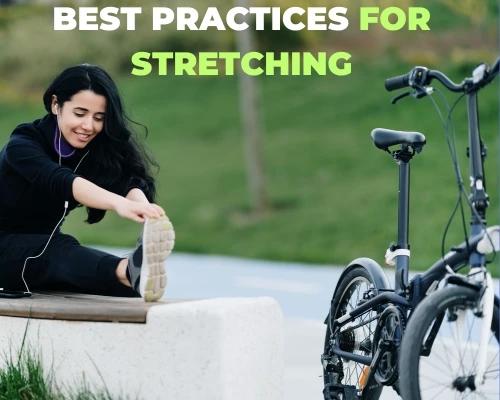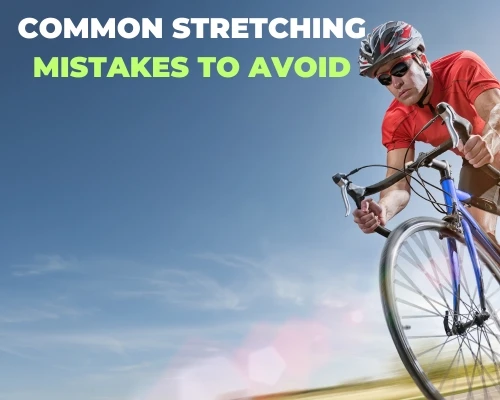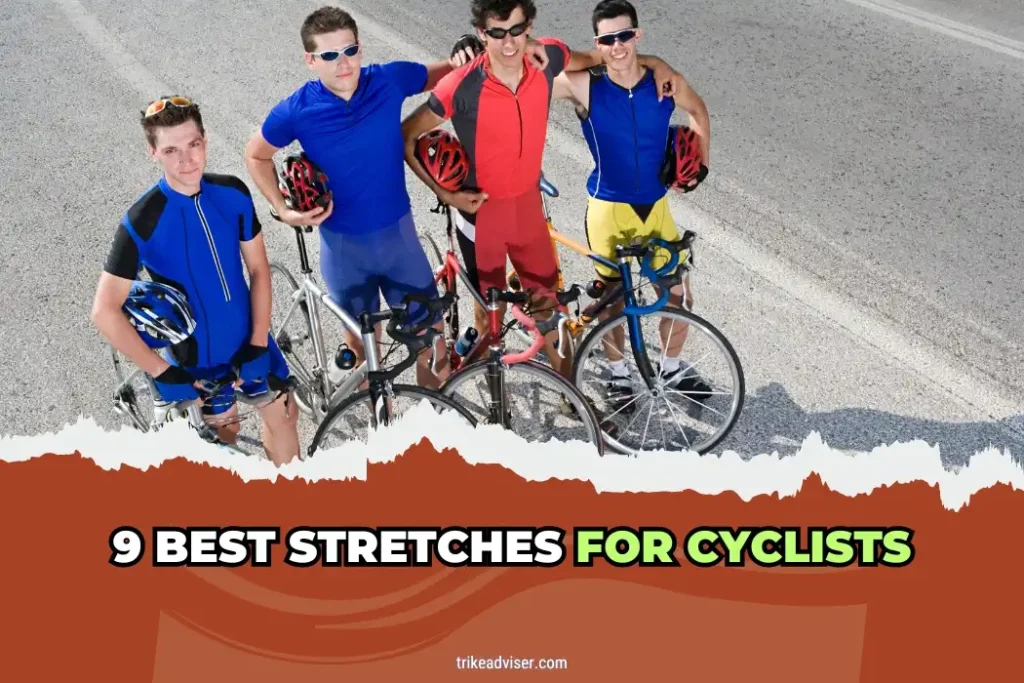Tight legs after a ride? You’re not alone. Cyclists often overlook the importance of stretching. Yet, skipping it can lead to tight muscles and long-term discomfort. The solution seems simple: stretch more. But what stretches work best for those who spend hours pedaling?
Our guide to the 9 best stretches for cyclists targets these common pain points. Ever feel that stubborn ache in your lower back? Or that nagging tension in your hips and hamstrings? We’ve got you covered.
These stretches aren’t just random moves. They’re a cyclist’s toolkit for better flexibility and injury prevention. Ready to loosen up and enhance your riding experience? Read on, and discover how these stretches can transform your cycling and recovery.
9 Best Stretches for Cyclists
Calf Stretch into a Wall
Pressed against a wall? Stretch those calves. Stand, one leg back, heel down. Switch after 30 seconds. Essential for pedal power.
Supported Bound Angle Pose
Sitting with feet together, knees dropped open? Use cushions. It opens hips and groin, boosting pedal efficiency. Hold up to one minute.
Three Point Hamstring
Lying back, leg up, pulling with a strap? Rotate in, then out. Hamstrings flex, reducing back strain. Essential for long rides.
Leg Circles
Leg up, strap on, circling? Smooth hip joints are crucial. Ten circles each way per leg. Keep it controlled.
Lizard
Step into a lunge, drop to elbows, or stay on hands. Stretches hip flexors, quads. Hold 30 seconds. Boosts pedal thrust.
Kneeling Lunge
Kneel, step forward, lunge. Hips down, stretching psoas, hip flexors. Key for posture, power. Hold 30 seconds each side.
Standing Quad Stretch
Stand, bend knee, heel to buttock. Balances, stabilizes. Essential for effective pedal strokes. Hold 30 seconds each leg.
Standing Calf Stretch
A step edge? Ball of foot on, heel down. Switch after 30 seconds. Strong calves, stronger strokes.
Hip and Lower Back Stretch
Back down, knees bent. Cross leg over, pull other toward you. Eases hip, back tension. Hold and switch.
The 9 Best Stretches for Cyclists

Three Point Hamstring
Detailed Overview
Target: Hamstrings & Low Back. Steps: Stand, feet hip-width, hinge at hips, reach for the floor.
Benefits
Boosts hamstring flexibility, crucial to avoid muscle damage and back issues.
Standing Quad Stretch
Detailed Overview
Target: Quads & Hips. Steps: Stand, bend one knee, grab your ankle, pull towards your butt.
Benefits
Enhances quad and hip flexibility. Essential for optimal knee function and riding performance.
Standing Calf Stretch
Detailed Overview
Target: Calves & Achilles. Steps: Stand, step one foot back, heel down, lean forward.
Benefits
Eases calf and Achilles tension. Key for effective pedaling and injury prevention.
Hip and Lower Back Stretch
Detailed Overview
Target: Hips & Lower Back. Steps: Sit, cross legs, twist towards bent knee.
Benefits
Reduces hip and lower back tightness. Increases comfort on long rides.
Hip Flexors and Psoas Stretch
Detailed Overview
Target: Hips, Groin, Thoracic Spine. Steps: Kneel, one foot forward, lunge, back knee down.
Benefits
Improves hip mobility. Facilitates smoother pedal strokes, lessens lower body strain.
Simple Lizard Stretch
Detailed Overview
Target: Hips, Shoulders, Spine & Obliques. Steps: Lunge position, hands inside front foot, lower elbows to floor.
Benefits
Boosts flexibility in hips, shoulders, spine. Crucial for maintaining correct posture.
Kneeling Lunge
Detailed Overview
Same as Hip Flexors and Psoas Stretch.
Benefits
Enhances hip flexor flexibility. Critical for maintaining a powerful cycling posture.
Supported Bound Angle Pose
Detailed Overview
Target: Chest & Back. Steps: Sit, feet together, recline on bolster, hold 5-10 minutes.
Benefits
Relaxes chest and back. Improves breathing, posture during cycling.
Consistent Stretching: Experts like Chris Carmichael recommend stretching 2-3 times a week. Helps maintain muscle health, flexibility. Crucial for every cyclist’s routine.
Best Practices for Stretching

When to Stretch: Before vs. After Cycling
Before Cycling
- Dynamic Stretches: Warm up with movements like leg swings. Prepares muscles and joints.
- No Static Holds: These might sap your strength. Save them for after the ride.
After Cycling
- Static Stretches: Time to cool down. Stretch slowly and hold. Aids in recovery.
- Target Major Muscles: Focus on legs, back, arms. Reduces stiffness.
Proper Techniques to Avoid Injury
Dynamic Stretching
- What to Do: Include movements such as arm circles, gentle twists.
- Benefits: Increases muscle temperature, prepares joints for activity.
Static Stretching
- Duration: Hold each stretch for 30 seconds, longer if possible.
- Method: Stretch until you feel tension, not pain.
- Recovery Enhancement: Helps restore posture, increases flexibility.
Proprioceptive Neuromuscular Facilitation (PNF)
- Technique: Stretch, contract, and relax.
- Benefits: Increases elasticity and motion range, helps prevent injuries.
- Ideal Timing: Best after rides or during separate sessions.
Key Stretching Tips
- Avoid Bouncing: Keep all movements smooth to avoid injuries.
- Breathe Freely: Don’t hold your breath. Helps with deeper stretches.
- Regular Routine: Consistency improves flexibility, reduces injury risk.
Common Stretching Mistakes to Avoid

Stretching Before Warming Up
- Error: Stretching cold muscles as a warm-up.
- Misconception: Ready to go after just stretching.
- Tip: Warm up first with a ten-minute brisk walk or light jog. Prepares muscles better.
Not Knowing the Difference Between Static and Dynamic Stretching
- Error: Mixing up static and dynamic stretches.
- Misconception: Both stretches are good anytime.
- Tip: Dynamic before riding to warm up. Static after to cool down.
Not Stretching Enough or Not At All
- Error: Skipping stretching or rushing it.
- Misconception: Stretching isn’t that important.
- Tip: Regular stretching prevents injuries, boosts posture. Aim for at least 20 seconds per stretch.
Bouncing During Stretches
- Error: Bouncing to extend a stretch.
- Misconception: Bouncing gets muscles longer.
- Tip: Keep stretches smooth and steady. Reduces injury risks.
Aggressively Stretching an Active Injury
- Error: Pushing hard on injured areas.
- Misconception: Stretching heals all injuries.
- Tip: Go easy on injuries. If swollen or painful, skip stretching.
Stretching to the Point of Discomfort
- Error: Stretching until it hurts.
- Misconception: Pain means effective stretching.
- Tip: Stretch should feel good, not painful. Hold gently for 20-30 seconds.
Hyperextending Joints
- Error: Locking joints during a stretch.
- Misconception: Deeper stretch by locking out.
- Tip: Keep a slight bend in the joints. Avoid overstretching.
The Role of Flexibility in Cycling
Flexibility shapes how you ride and how well you perform. Let’s dive deeper.
How Increased Flexibility Contributes to Better Riding
- Optimal Posture: Flexibility lets you hold an aerodynamic posture easily. Less strain, more speed.
- Injury Reduction: Flexible muscles and joints withstand cycling demands better. Fewer injuries, less downtime.
- Efficient Power Output: Flexibility in hips and back translates to stronger, more effective pedal strokes.
Long-term Benefits of a Flexible Body for Cyclists
- Joint Health: Regular stretching keeps joints healthy. Say goodbye to stiffness and chronic pain.
- Muscle Balance: Flexibility training evens out muscle tension. Leads to better alignment and performance.
- Enhanced Comfort: A flexible body experiences less pain. Enjoy longer rides with more comfort.
- Injury Recovery and Prevention: Flexible muscles recover faster. Regular stretching prevents future injuries.
As an Amazon Associate, I earn from qualifying purchases, at no additional cost to you. Read Our Affiliate Disclosure.

